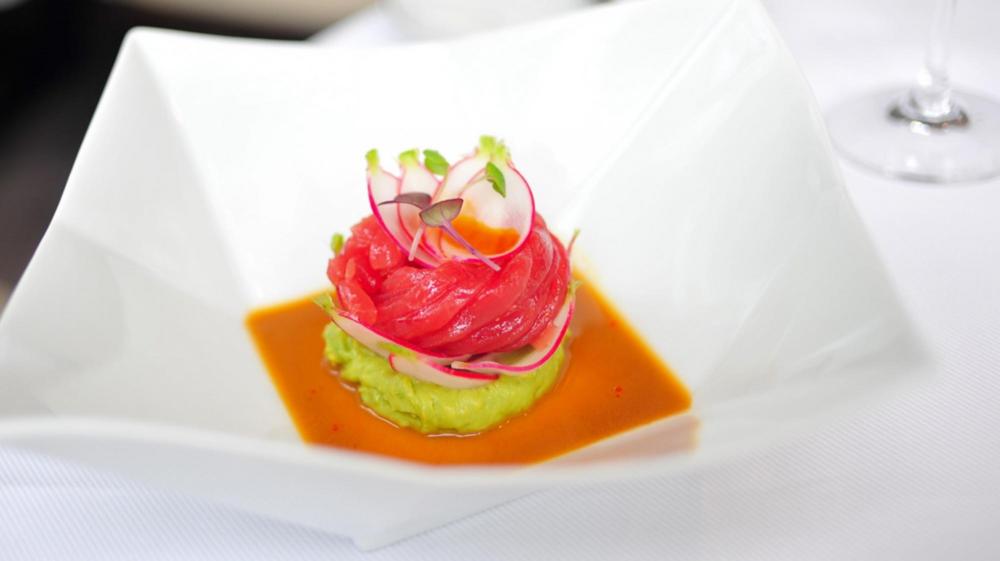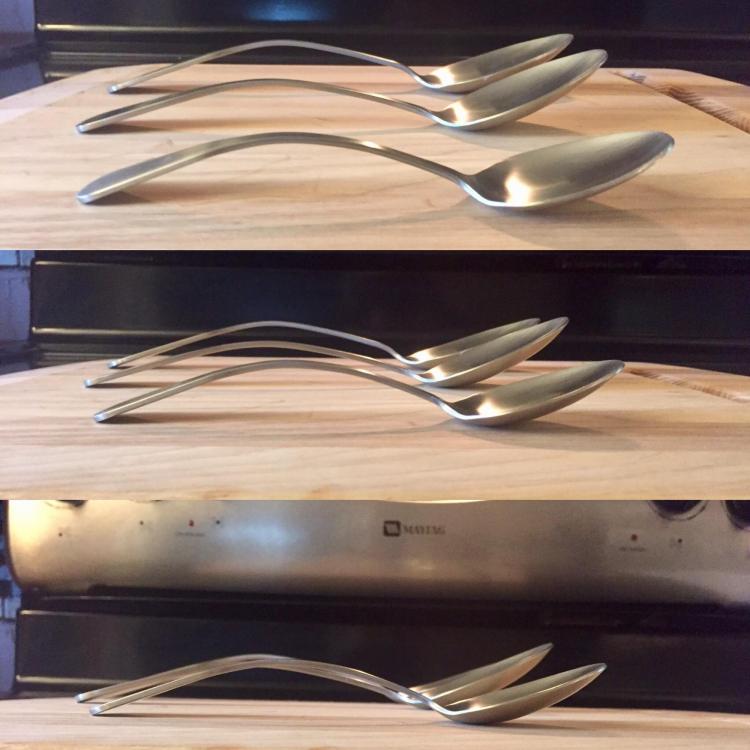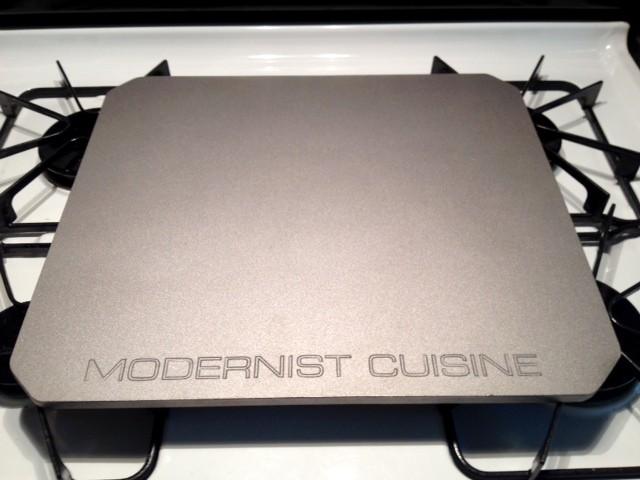-
Posts
1,807 -
Joined
-
Last visited
Content Type
Profiles
Forums
Store
Help Articles
Everything posted by btbyrd
-
-
It just looks like a French top to me... maybe two of them back to back. Or maybe two planchas.
-
From what I can gather, the main US importers of Japanese steel are: Epicurean Edge Korin Yoshihiro Chef Knives To Go Japanese Knife Imports There are probably more that I'm missing.
-
You're probably right. I see that the Vacmaster UK site says that FS bags will work with all of the VM machines. I've never bother to try with mine, but have heard people say that the waffling is the reason that the Foodsaver bags aren't recommended. Never anyone authoritative though. At any rate, the manuals and spec sheets don't even mention non-chamber bags. Is the seal bar on the bottom popping up when the seal cycle starts? You can hear it knock against the bar in the lid if it's working properly.
-
Food Saver bags don't work with the VP112S, as far as I can tell. (I have the "non-s" VP-112 and it doesn't use them.) The VacmasterFresh site and the first few vendor descriptions I looked at only mention using chamber vacuum bags. The waffling/channels on the FS bags gets in the way of a proper seal. The machine will seal after the vacuum timer has completed its cycle; air only comes back into the chamber after the seal cycle has finished. If it sealed the bag after air had re-entered the chamber, there'd be air in the bag. Do you hear the air coming back into the chamber when the sealer's done?
-
Even though I'm not very good at sharpening -- I can't reliably produce the hair-shavingly sharp edges you see in videos -- I can still get my Globals sharper using stones than using any of the "pull through" devices I've used, like Global Minosharp handheld sharpeners or the "speed sharpener." I have a ceramic hone from MAC, but that's only really good for realigning the edge, not cutting a new one. If you really want to sharpen a knife, you've got to remove some metal, and the rod-sharpeners can't grind down the blade like you need to. In a home kitchen where you take reasonable care of your knives, it's not necessary to sharpen very often (though you should obviously hone your blades frequently). Which is nice, because it can be a bit of a chore depending on how many knives you need to sharpen and how refined you need the edge to be. If you're just touching up a single knife and getting it super sharp, it's not a big ordeal; if you want to refinish five or six knives, it's going to take a while. There are lots of online resources about how to best use stones. I got into it when ChefSteps first did their knife sharpening course back in the day. Korin and Japanese Knife Imports also have some great videos up. I can't comment on the knock-off EP or the Shapton stones since they have yet to arrive.
-

Best 2 bits of kitchen gear you obtained in the last 2 years?
btbyrd replied to a topic in Kitchen Consumer
I'd really like a CSO, but I want a 33% larger "pro" version. -

Best 2 bits of kitchen gear you obtained in the last 2 years?
btbyrd replied to a topic in Kitchen Consumer
Yep! These are great and so cheap. I use the scraper all the time for random tasks; it's the perfect shape for a lot of tasks you might not even know you needed to do. I love the slim spatula for scraping out the blender pitcher. I use the iSi wide spatula more often in everyday cooking... it's flexible enough to scrape down the bottom of a pot or pan, but still rigid enough at its core that it won't flop around on you. That's true of all these iSi things, actually. Add a wide spatula while you're at it. The good news is that, as far as kitchen stuff goes, these things are pretty inexpensive. A perfect gift for yourself or others! -

Best 2 bits of kitchen gear you obtained in the last 2 years?
btbyrd replied to a topic in Kitchen Consumer
I'm an early adopter and I spent most of my kitchen-stuff money more than two years ago, so my buying has slowed a lot. But of what's come in recently... 1) Dartos - Carbon steel pans are a joy to cook with. I happen to like the aesthetic and performance of the Dartos. The sear you can get is pretty baller. I wish they had one bigger than the No. 27, though you can sear some BIG bits with the No. 27. Anyway, if you can only get one - get the 27. If you can only get 2, get the 27 and the 23. ... although the #20 is the *perfect* size to fry two eggs in... 2) Vollrath Mirage Pro Induction HOB - I got a stupid-fresh eBay deal of $125 on a used model (that had seen some use, but was so cheap I couldn't complain). In my past two houses, the crappy gas ranges have really only had three settings: high, low, and off. The 100 levels of power on the Mirage Pro gave me the control I needed when the ranges failed. It can maintain pressure on my pressure cooker without venting -- something that I couldn't do on the stovetop or with the cheap induction hob I had been using before. I bring it with me when traveling during Thanksgiving and Christmas so I can sear stuff hard outside and not smoke out the house. Honorable mention) Joule - My second circulator, after the Polyscience Pro. The Joule is so much smaller and quieter, and is able to operate in so little water. I can keep it in a drawer and bust it out in no time. Things that didn't quite make the 2-year cut: VP-112 chamber vacuum; Waring X-Treme commercial blender; Mafter exoglass chinois; Bernzomatic TS8000 + Searzall. I'd say my Polyscience, but that's been around for a lot longer :-) -
Well, the handles are different too. Apart from that, the one you linked to is "kasumi" grade while the one I linked to is "hongasumi" grade -- which is supposed to be a slightly higher quality knife with respect to fit and finish. I don't know what that actually means (or what exactly is supposed to be higher quality about it) and the knives appear to be similar overall so the "grades" might just be a kind of marketing thing -- at least, with respect to these "low end" high end knives. In any event, the one I got runs $10 more than the one you linked to. I don't think there's a world of difference between them... but I don't really know. I already have a set of cheaper cheap synthetic stones (400/1k/3k/6k) but I just picked up a knock-off Edge Pro with some non-knock-off Shapton glass aftermarket stones. I'm not super skilled with freehanding -- yet -- and I figure the EP system will give me an easy way to get a consistent edge. Of course, the EP doesn't really do much as far as blade resurfacing is concerned, so it's not a full substitute for waterstones. It'll be nice to have around though.
-
I admit it. I'm a bad influence. Yep, that's a rosewood handle. It's the same knife I linked to above.
-
-
Thanks for sharing your experience! While I'm going on a bit of a binge, I have a strategy that basically is to (1) buy knife-styles that fill gaps in my present setup that (2) are the least expensive version you can buy that doesn't have fit and finish issues or major problems with the grind. Like you, I use two or three knives for 90% of kitchen tasks, and I don't want to spend a ton of money and eat up a lot of space to buy redundant blades or things that I'd never really need. At the moment, I don't really have any petty knifes that I like, so the 105 and 150mm ones I ordered will be a welcome addition for smaller tasks. I have a Global "nakiri" that I use all the time for veg, but it's small and doesn't have the rectangular blade typical of many knifes in the style. And you can pick up a beautiful blue steel nakiri for not a ton of money. The thing that I keep going back and forth on is whether or not to get a usuba instead, but I figure that if I really need to do things that single-bevel excels at (like sheeting vegetables) I can always give it a try with the yanagi. Really, the only knives that are high on my radar are a nakiri/usuba and either a gyuto or a kiritsuke as an alternative to my nice-but-pedestrian Global 8" and 11" chefs knives. I'm leaning toward this kiritsuke and this nakiri. That nakiri has been on my Amazon wishlist for literally years.
-
Great knife! Funny that you compared it to a Lambo... one reviewer of the petty I bought from Yoshihiro compared theirs to a Ferrar, asking "did you ever hear about someone cleaning out an decrepit barn and finding a priceless vintage Ferrari hidden beneath an old tarp? This is that Ferrari, and the black Kurouchi tarp has been lifted just enough to reveal a cutting edge so incredible it's going to leave you grinning ear-to-ear, like you just did 0-60 mph in 3.2 seconds." Well, mine won't be here for another week or so, but I'm starting to expect some epic Italian performance from my Japanese steel. Also, thanks for conveying your experience with sayas. I wasn't aware of the difference between compression and non-compression sayas, so that's something to be on the watch for in the future. Right now, I'm just trying to stop myself from buying a nakiri, kiritsuke, and burly Western-style deba. It's hard work.
-
There are so many beautiful knives in this thread, I don't know where to start. You guys are ballers. I just went on the start of what I hope will be a short buying spree of Japanese carbon steel knives. For years, Globals have been my go-to knives for most tasks. As I understand it, Global was one of the first major Japanese manufacturers to break through in the US, which makes sense considering that their knives are soft and stainless and mostly double-edged. I've liked mine while I've had them, but I'm anticipating a serious change in my cutting and slicing world. Up until now, everything has been stainless and everything has been stamped. My go-to Globals are the 8" G-2, a 6" nakiri-ish style veg knife, and (most recently) a 270mm chef's knife (that was probably my best knife purchase thus far). I also have a bunch of Wustof that I inherited from my parents (who upgraded, not passed on) though I mostly use the santoku. Anyway, I've always wanted a yanagiba. I don't make sushi, and I seldom work with fish. But on those rare occasions when I want to slice fish like I want to slice fish.... that is the knife I dream of. And when Yoshohiro started their recent yanagi promotion, I picked up their cheapest 300mm white steel #2 with saya. It will be here Saturday, but from what I can gather, it's sort of an absurdly inexpensive knife of its type given the quality. I paid $234 for a 12" forged blade... and it comes with a saya? I mean... shut up and take my money. Then I got to thinking. I've never had a pairing knife -- or short blade -- that I really gelled with. My current pairing knife is a Wusthof, which is fine and all, but I never want to reach for it for anything. And then I came across a 105mm petty from Chef Knives To Go. It's only $60. Who could say "no"? At this point, my mind started racing. What did I need? One thing I've always wanted was a longer petty - something that was thin and agile and thin (ish... something tall enough for some board clearance). And that's when I found her. A 6-inch double-edged super blue petty from Yoshihiro. Good lord. What have I done? My only problem was that it didn't come with a saya. So I fired off an e-mail, and they replied that their knife-maker would gladly make me a custom lacquered saya to fit that blade. For the low, low price of $25. I couldn't fill out the Paypal invoice fast enough... SHUT UP AND TAKE MY MONEY! I have a few more blades on my radar. But I think I'm going to play it cool for right now and see how I adapt to the new steels. I know that I'll have to adjust my cleaning and drying regimen, but that's not a huge deal. A few years ago, ChefSteps launched a knife sharpening class, which prompted me to buy a whole buncha stones and whatnot. And I love, love, love how the Globals perform fresh off the stones. But they're super soft by Japanese standards, and I hate how quickly they lose their edge (though the Hi-Soft cutting board I purchased recently is a godsend in this regard). I'm hoping that I can sharpen up my super blue petty and keep an edge (using the hi-soft) for a week or so of casual cooking. We'll see what happens. Pictures to come.
-
-
It's just strips of yellowfin cut into thin strips. I was inspired by a dish I had a while ago at one of Jean-Georges Vongerichten's restaurants in NYC -- "The Spice House". When I ate it, the plating was different and it was served with different garnishes (I recall tapioca pearls). He also had a similar version at his flagship restaurant, with different garnishes, pictured below. After I visited The Spice House, I got Jean George's "Asian Flavors" cookboook, that had a recipe for Tuna Ribbons. Here's a snapshot from the cookbook: I'd always been curious about getting that magical looking plating. First things first, I did the ChefSteps "salgar" dry cure trick on my tuna loin. After the ice water bath, I blotted it dry, wrapped it in paper towels, and popped it in the freezer for 10 minutes. Then the slicing began. I used my Global G-17 27cm chef's knife on a Hi-Soft board I got from Korin. Sharp knives and good boards matter. Cut the tuna into thin strips, wiping the blade down with a moist side towel after every other cut. Once the tuna was cut, I placed it in a bowl with some sesame oil diluted with some neutral olive oil. The JG recipe says to coat them with canola or another neutral oil. Either way, you need to do that to keep the tuna ribbons from sticking to each other. Just prior to service, I dressed them with some quality soy sauce. I wasn't really sure how to plate it. The Three Star Michelin Jean-Georges presentation looks freaking phenomenal in its highest iterations. Here's a pic that I found on Flickr from user Ulterior Epicure: I have no idea how that nesting is done. I have some ideas, but that'll require some more experimentation. But what I did was grab a ring mold and just layer it in one ribbon at a time. It sounds like it'd take a while or be complicated, but I layered all that in there pretty quickly and easily. I was surprised. To make things easier, I moved all the tuna ribbons from their sesame-olive-oil bowl to a parchment-lined sheet tray, with all the strands lined up the same way, which made it easy to grab each new one and layer it on. The color of my tuna is in large part due to the soy sauce, but I used a light-colored high-sodium usukuchi soy sauce to keep it as bright as possible. The other factor is the lighting in my kitchen, which is garbage. But I'll attach another picture with better color and a different perspective just for good measure. I will say that it was freaking delicious and very, very simple. It's basically just tuna, an avocado, and a sharp knife. I just wish I had had some radishes...
-
-
I've got the fever. I seriously can't justify it though. I have no where to put it and no money to spend on it. Just like the $600 juicer I'd want to buy along with the Spinzall. For now, I've got some SPL and a Chemex. It just ain't the same.
-

Ruhlman / Dalton Spoons, Utensils, and Kitchen Accessories
btbyrd replied to a topic in Kitchen Consumer
Small, medium, and large spoons beside one another at various angles. Small in front; medium in middle; large in back. The perspective makes them look like they're almost the same size, but that's an optical trick. I tried to more or less line them up where the handle meets the cup of the spoon. I'm sure there will be another Black Friday or Cyber Monday deal this year, so if you can wait you can save. -
+1 for the affordable circulator. Everything else has been evolutionary. Circulators have been revolutionary.
-
You have my deepest sympathies.
-
I mean, the only thing I can think of is that the rust was caused by dew in the nighttime. It went onto the grill new, seared some steak, and then cooled down overnight in the (covered) grill. The next morning: rust. I don't know what the deal is. It might have just been a fluke. At any rate, the seasoning that comes on the steel is pretty minimal. I'd say that it's akin to the initial layer of seasoning on a carbon steel pan. It's so thin that the steel looks steely and metallic rather than the blackened coating that comes with layer upon layer of polymerized oil or years of use. I don't think that it needs to come with that level of seasoning though. As for a good peel, I use the Super Peel. The design is very helpful in getting things on and off the peel.
-
Pizza Craft sells stainless ones in addition to some ceramic, Thermabond, and cast iron pizza things. Their steel comes pre-seasoned as well. Upkeep is just like cast iron or carbon steel. Don't let it hang out around water. I repeat: do not let it hang out around water. When I first got mine, I put it on my grill and used it like a flat top. The steel was too hot to remove that night, so I let it cool down outside in the grill. It did not rain that night, but it was cool, and some dew had condensed, evaporated, and oxidized the steel. Rust spots. Getting those bitches out was several-day long project, but I was able to strip, clean, and reseason it with some effort. The techniques aren't any different from cast iron or carbon steel, but the sheer size and weight of these things presents a bit of a challenge. Just for fun, here are some pics of the process: This was the steel new, out of the box. And here it is the next day. I had scoured it with steel wool, so there's a thin, red layer of rust on it, but you can see some of the distinct spots. After some time with some metal sandpaper and some oven cleaner, I was able to strip it down to this base layer. It looks a bit dark in places (like the lower left corner) but that's mostly old seasoning that I didn't need to fully remove. This is after five rounds of seasoning in the oven. It's jet black and totally smooth. Looks like cast iron, but it's definitely steel. So that was a pretty awful experience, but the seasoning is now top-knotch. KEEP YOURS DRY.
-
The original Baking Steel people ship to Canada. It costs a lot ($49, including all customs fees) but steels are heavy so it makes sense. I did a quick search on Amazon.ca, and one of the first results was a steel from Pizzacraft that's inexpensive and has free shipping. There are a few other options available. None appear to be pure iron. But all the steels I'm aware of (including the Modernist Cuisine version I got from Baking Steel) are vulnerable to rust and should be kept dry and well-seasoned like a carbon steel pan.





.thumb.jpg.485c2d05d3999dad7bc891e56f867562.jpg)


